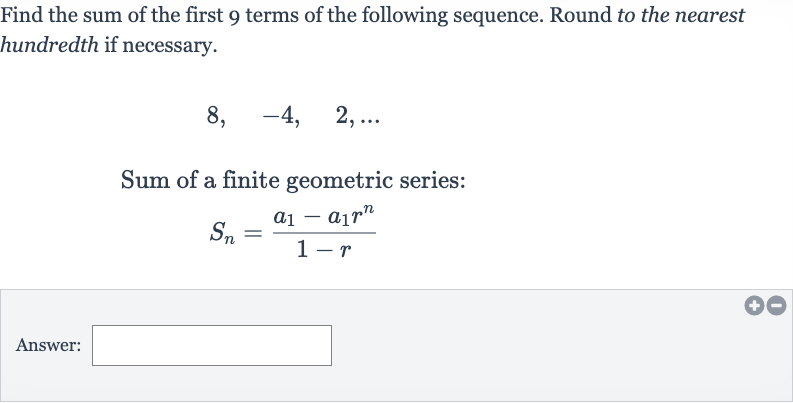Full solution
Q. Find the sum of the first terms of the following sequence. Round to the nearest hundredth if necessary.Sum of a finite geometric series:Answer:
- Identify sequence type: First, we need to identify the type of sequence we are dealing with. The sequence appears to be a geometric sequence because each term is obtained by multiplying the previous term by a common ratio. To find the common ratio , we divide the second term by the first term.
- Calculate common ratio: Next, we use the formula for the sum of the first terms of a geometric series, which is:where is the sum of the first terms, is the first term, is the common ratio, and is the number of terms.
- Use sum formula: We plug in the values we know into the formula to find the sum of the first terms: (the first term) (the common ratio) (the number of terms we want to sum)
- Calculate : Now we calculate the value of :
- Substitute into formula: We substitute this value into the sum formula:
- Simplify expression: We simplify the expression:
- Divide by reciprocal: To divide by a fraction, we multiply by its reciprocal:
- Simplify fraction: We simplify the fraction by dividing both the numerator and the denominator by their greatest common divisor, which is :
- Convert to decimal: Finally, we convert the fraction to a decimal to round to the nearest hundredth if necessary:Rounded to the nearest hundredth,
More problems from Find trigonometric functions using a calculator
QuestionGet tutor help
QuestionGet tutor help
QuestionGet tutor help
QuestionGet tutor help
QuestionGet tutor help
QuestionGet tutor help
Question
. Find the value of in degrees.Write your answer in simplified, rationalized form. Do not round.____
Get tutor helpQuestionGet tutor help

